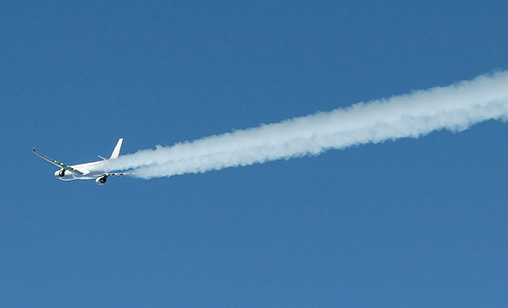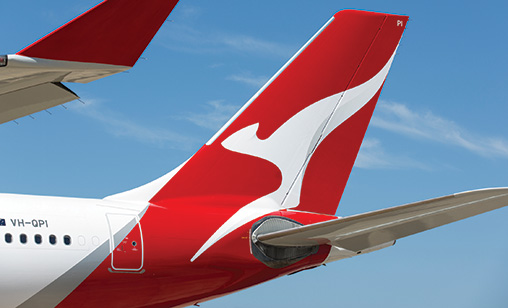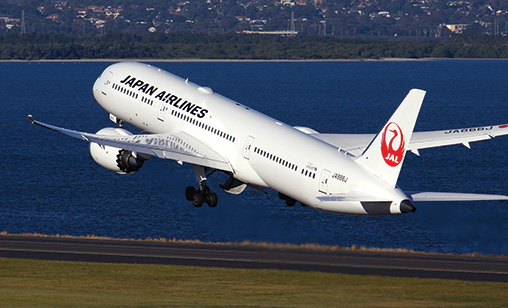Main Story
No backing off lower emissions targets promises industry
Global aviation remains on track with its commitment to achieving a 50% reduction in emissions by 2050 from 2005 levels, reports associate editor and chief correspondent, Tom Ballantyne.
October 1st 2020
With aviation losses mounting by billions of dollars a month from the coronavirus pandemic, the industry could be forgiven for losing sight of ambitious environmental targets. Read More » Mid-pandemic, survival is the name of the game as airlines slash capacity and store thousands of jets in airline parking lots; a situation that probably delights an extremist wing of the climate movement that has long targeted airlines as major global polluters.
Despite the enormity of the crisis the airline industry is experiencing, it has recommitted to its ambitious emissions reduction targets. “The bottom line is it’s still critically important for the industry to continue to push for sustainability and meet the 2050 targets set in stone in 2016,” said former CNN journalist and Head of Communications Environment at the International Air Transport Association (IATA), Andrew Stevens.
 |
“There is no doubt this is going to be more difficult given the financial situation of the airlines, but we have not seen clear evidence airlines are pulling back on their commitments. For example, I have not seen anything that suggested, at this stage at least, that airlines will not honour their commitments to the uptake of sustainable aviation fuel.”
It is a view shared across the industry. Last month the oneworld alliance, which represents 13 major airline groups, including leading Asia-Pacific carriers Cathay Pacific Group, Japan Airlines and the Qantas Group, re-confirmed its commitment to net zero carbon emissions by 2050. It is the first global airline alliance to unite behind a common target to achieve carbon neutrality.
Also in September, manufacturer Airbus announced developments in its hydrogen powered jet. Rival Boeing is continuing its research and the design of the B787 ecoDemonstrator in joint partnership with Etihad Airways.
Engine manufacturers, whose development work is critical to achieving ultimate sustainability, are pursuing emissions mitigation programs. “The pandemic has actually brought the aviation industry forward by focusing attention on sustainability and how we need to advance technologies that help the aviation industry drive down CO2 emissions,” Pratt & Whitney senior vice president, engineering, Geoff Hunt, told Orient Aviation last month.
As a result of the pandemic, the engine manufacturer has reduced its workforce, cut capital expenditure and prioritized investments, but Hunt said one program Pratt & Whitney has kept front and centre is the Geared Turbofan™ engine (GTF™). “We believe the geared turbofan architecture we pioneered has room to develop and deliver improvements in fuel efficiency and lower emissions, particularly NOx,” he said.
Rolls-Royce has announced the completion of tests on ground-breaking technology that will power the world’s fastest all-electric plane. “Rolls-Royce’s announcement follows the unveiling of Airbus’s three zero-emission commercial aircraft models. It is another indication aerospace companies are increasingly attempting to align their businesses to a future market emphasising climate consciousness, GlobalData Aerospace and Defense Associate Analyst, Harry Boneham, said.
Results of a poll conducted by Globescan, released in September, identified growing numbers of people are “very concerned” about climate change, despite the pandemic and the subsequent economic impact of the virus. Across the 27 countries surveyed, around 90% of respondents viewed climate change as a very serious or somewhat serious problem. That finding has strengthened in recent years. In the UK, long time climate change advocate, the Prince of Wales, has warned the climate crisis will “dwarf” the impact of the pandemic.
At the turn of the month, China joined the front line of the anti-emissions flight with President Xi Jinping’s commitment for his nation to reach carbon neutrality by 2060.
 |
For more than a decade, aviation, with IATA as its lead spokesperson, has been at the forefront of seeking the science to address the global challenge of climate change and establish ambitious targets to mitigate CO2 emissions from air transport. The targets remain to achieve an average improvement in fuel efficiency of 1.5% per year from 2009 to 2020, a cap on net aviation CO2 emissions from 2020 (carbon neutral growth) and a 50% reduction in net aviation CO2 emissions by 2050 relative to 2005 levels.
In March, Montreal-headquartered International Civil Aviation Organization (ICAO) agreed the types of carbon offset units eligible for compliance with the world’s first global sector climate mechanism, the Carbon Offsetting and Reduction Scheme for International Aviation (CORSIA).
MORE THAN 80 COUNTRIES HAVE COMMITTED TO THE INDUSTRY’S CARBON OFFSETTING SCHEME
At press time, 82 countries had agreed to participate in the first and voluntary phase of CORSIA. It is estimated about 80% of the growth in international aviation’s CO2 will be covered by the scheme from the end of this year.
These developments were debated at the Air Transport Action Group’s (ATAG) 2020 Global Sustainable Aviation Forum - Green Recovery, a virtual, on-line event at the turn of the month that brought together representatives from all sectors of the industry to discuss aviation sustainability beyond COVID-19.
ICAO council president, Salvatore Sciacchitano, told the ATAG virtual summit “health and safety, and the fundamental economic viability of operators must be assured”.
“But we also must recognise the opportunity this crisis provides to build back commercial aviation greener,” he said.
ATAG executive director, Michael Gill, said “2020 was supposed to be, alongside 2019, the baseline for the CORSIA programme”.
“An average of the two years was agreed to smooth any potential downturn in traffic in either year, but a situation as grave as the one we face was never contemplated. It is much too early to determine the impact of COVID-19 will have on the CORSIA baseline. We will continue to monitor how the situation evolves over time. However, any modelling done today will be out of date in a week,” he said.
 |
“It is very clear 2020 is a completely abnormal situation. In the meantime, we have an industry to rebuild and a world to reconnect.”
While there is a major reduction in aviation’s contribution to global emissions this year given the number of aircraft on the ground, at some stage growth will resume. IATA’s Stevens said: “For the return to normal growth we are forecasting 2024, but the numbers just get worse and worse.
“We have not updated that, but we will have a new financial forecast for the industry around the AGM in November. I can’t imagine they are going to be any better. They could be worse.
“Given this has gone on a lot longer than anyone thought, returning to normal may be pushed further and further out. There is a school of thought the trajectory of growth in the airline industry post COVID-19 will not return [to past performance]. We will go back to growth rates but we won’t be at the same level of air traffic in numbers by 2050 that we expected before the crisis.”
The pandemic has removed large numbers of bigger, less fuel-efficient aircraft from airline fleets. “I guess you can say it’s a bit of a double-edged sword,” said Stevens. Airlines are taking the big ones out of service but the other side of the coin is fleet renewal will be more of a challenge, that is getting more efficient planes to replace the older planes, he said.
“I can’t see fleet renewal will continue at the pace it was originally planned, at least not in the immediate few years. Yes, the environmentalists will be pretty happy when they look up at the sky now, but the bottom line is the world still needs air travel and connectivity. The COVID crisis will reveal what it means to the global economy when you do not have air travel, when you do not have planes in the sky,” he said.
ONEWORLD ALLIANCE COMMITS TO NET ZERO EMISSIONS BY 2050
Oneworld’s environmental goals underscore its carriers’ sustainability focus. The alliance’s chairman and Qantas Group CEO, Alan Joyce, said the commitment of oneworld members to reach net zero emissions by 2050, from 2005 levels, “underlines the importance we, as an alliance, place on becoming a more sustainable industry. Despite the challenges we are all facing from the COVID-19 pandemic, we have not lost sight of the responsibility we have to reduce emissions in the long term. Today’s announcement reflects the strength of that commitment.”
Japan Airlines (JAL) president, Yuji Akasaka, said his airline fully recognises the industry will play a vital role in promoting a sustainable future and proudly supports the alliance in achieving net zero carbon emissions by the year 2050. “In recent years, the JAL Group has invested in the development of sustainable aviation fuel to contribute to building a firm supply chain for the airline industry,” he said.
Malaysia Airlines Berhad CEO, Captain Izham Ismail said: “Congratulations to the oneworld alliance, Malaysia Airlines is proud to be in support of this amazing initiative together with our fellow member airlines towards driving the long-term sustainability of the aviation industry. We seek to play a greater part in building a legacy for future generations and are enhancing our own airline’s contribution to global sustainability efforts.”
Interestingly, the oneworld targets are well ahead of IATA’s goals. Several member airlines are actively prioritising a range of environmental sustainability initiatives. IAG (the parent of member carriers British Airways and Iberia) was the first airline group worldwide to commit to net zero carbon emissions by 2050. JAL and Qantas also have targeted net zero carbon emissions by 2050, while Finnair is aiming even higher, with the goal of carbon neutrality by 2045.
“They’ve decided they are going to go carbon neutral, zero emissions by 2050 that is more aggressive than IATA, which is fantastic,” Stevens said. “And to say this in the middle of the COVID crisis underlines a commitment and focus to doing this. 2050 is still a long way out but to have that reinforcement at this time is very gratifying.”
In some quarters, however, there remain questions about the ability of aviation to reach the 2050 targets. In a July report, senior associate, transportation and infrastructure research at Sustainalytics, Helene Gaudin, said airlines are in dire need of cash to recover yet the industry is expected to adapt and prepare itself for the more critical crisis of climate change.
“Despite the slowdown of air travel, long-term prospects for mitigating the carbon footprint of the industry are not clear. Carbon commitments supported by comprehensive programs are in place. Nonetheless, our research suggests existing measures may not be sufficient to curve down emissions and mitigate climate change,” she said.
The financial struggle of the industry and the required state support for it is a rare opportunity for governments to invest in cleaner solutions and dictate environmental conditions such as taxing fossil fuels and requiring the use of greener energy sources. It would undoubtedly be fiercely contested by airlines, already suffering under heavy tax burdens, she forecast.
IATA is fighting proposed environmental taxes in France, which it calculated would fail to decarbonize the aviation sector but would eliminate 150,000 French aviation jobs. The Convention Citoyenne pour le Climat (CCC) - a citizens’ body created under President Macron – is proposing measures to curb aviation emissions, including an eco-tax on tickets issued in France, to raise $4.9 billion annually. France already collects some of the highest aviation taxes in Europe. IATA director general and CEO, Alexander de Juniac, warned such unilateral national taxes could jeopardize CORSIA, which is calculated to mitigate a billion tonnes of carbon emissions.
Gaudin cited former EU (European Union) climate chief, Miguel Arias Cañete, who has predicted the end of the pandemic not only would return airline carbon emissions to their pre-COVID-19 levels but could exceed these levels if nothing was done. “The historical fall of fossil fuel prices also may impede the necessary actions to clean up the aviation industry and encourage a return to a ‘business as usual’ model that is undeniably damaging our planet,” Gaudin said.
AIRCRAFT RECYCLING COMPANIES FACING “A TSUNAMI OF DEMAND” FROM COST-CUTTING CARRIERS
Sustainability is not only about emissions. The pandemic is putting pressure on other sectors of the industry. In the field of aircraft recycling, planes dismantled for parts or scrap could double to 1,000 annually to 2023, up from roughly 400 to 500 planes a year since 2016, reported data consultancy Cirium. The fate of the world’s pool of grounded planes is being closely watched by the market for Used Serviceable Material, with one report from consultants Oliver Wyman forecasting “a tsunami of demand” for such parts as airlines cut costs.
The pandemic, which is expected to result in a 55% drop in 2020 passenger numbers, has prompted early retirements of older planes. While companies that park, dismantle and buy and sell used aircraft parts see opportunity in parked planes, a sudden increase in the supply of used parts risks depressing prices in the estimated $3 billion a year industry, despite demand from airlines seeking to lower maintenance costs.
Ultimately, Pratt & Whitney’s Hunt said there is no “silver bullet” to solving the climate impact of commercial aviation. “It will take a basket of solutions, including sustainable aviation fuels from green, non-food stock sources, electric and electric-hybrid and alternative fuel from renewable and green sources,” he said.
“Engine makers have been focused on reducing climate impact and increasing fuel efficiency for decades. In this regard, it took 20 years and a $10 billion investment for Pratt & Whitney to create the Geared Turbofan™ engine – the first new architecture engine of the modern era, and we intend to keep innovating solutions for the good of the planet.”
With aviation focusing intently on environmental goals, it is ironic the industry continues to be a target for climate action protagonists. The sensitivity of the emissions issue and the criticism of airline actions, despite their sustainability goals, won’t go away. One example, even in times of crisis, is the numerous “flights to nowhere”.
They take off on a sightseeing route and return to the same departure airport. They are being offered by airlines to raise cash and to operate some aircraft in desperate times. In the Asia-Pacific, they are being flown by All Nippon Airways, Japan Airlines, Taiwan’s China Airlines and EVA Air and Qantas - among others. Environmental campaigners are describing these limited flights as “gimmicks” and “simply emissions for the sake of it”.
Last month Airbus unveiled three concepts for zero emissions aircraft that could enter service in 15 years. All code-named ZEROe, they are a 120-200 passenger turbofan airplane with a range of 2,000 plus nautical miles, a turboprop model for 100 passengers powered by a turboprop engine instead of a turbofan engine and a blended wing body design for 200 passengers. In the blended wing body design, the wings merge with the main body of the aircraft. It will have a range similar to the turbofan and an exceptionally wide fuselage, Airbus said. All three concept aircraft rely on hydrogen as the primary power source. Airbus CEO, Guillaume Faury, said at the unveiling of the prototypes last month he strongly believed the use of hydrogen – both in synthetic fuels and as a primary power source for commercial aircraft – has the potential to significantly reduce aviation’s climate impact”. |